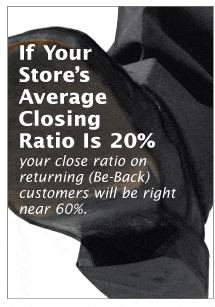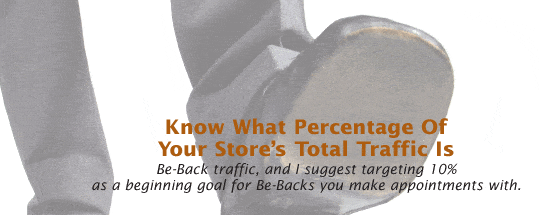A Strategy for Dramatically Improving Your Close Ratio and Average Sale.
Sometimes the way you think about a problem is the problem. I’ve seen hundreds of sales managers and business owners over the years struggle with how to get more productivity out of their salespeople without continually dropping prices and, thereby decreasing gross margins, or by flooding the store with more customers than the salespeople can handle by increasing advertising expenses, thereby decreasing net profits.
Everyone knows by now that the three elements in the sales equation for furniture stores are: Customer Traffic, Close ratio and, Average Sale, and that the sales manager’s role is to do something every day to improve any, or all, of these elements.

Problem is, most managers and salespeople want traffic to go up, which they believe is not their responsibility, but that of the owner or advertising manager. As is the case with much of human endeavor, they look outside themselves for solutions to problems when the real solutions lie inside themselves – within their sphere of influence and control. Sales managers who think this way are saying, in effect, “It’s not my fault”, and they have no effective plan of action to improve sales when traffic is good, or bad. If traffic goes down, sales go down, and that’s just the way it is.
Sales managers should understand that they are responsible for improving the other factors in the equation. If the first one, customer traffic, drops, they need to work in different ways with their people, taking sales performance into their personal realm of accountability.
They can work with individuals and teams to help each person perform at his or her personal best, using all of the training tools at their disposal, and all of the coaching tools – like observation, feedback, one-on-one performance improvement meetings, goal development and income management. In other words, they change from merely managing what happens, to making things happen. From management to leadership.
Each day, sales managers should be doing things to improve traffic, close ratio and average sale. Traffic? How can the sales manager do that? Isn’t that beyond the scope of her responsibilities? No, it’s not, and here’s how:
Be-Backs Defined
First, let’s define a term. Be-Back customers, for our purposes in this article, are customers who return to the store, and to the salesperson, on the same project. It doesn’t matter whether they return later this week, next week, next month, or three months form now – it’s the same project. OK?
You’ll have to take me at my word on this, but Be-Back customers buy at a rate 3 times higher than first time customers. My numbers show it, as do those of clients with whom I’ve worked during my years in consulting on this topic. If your store average closing ratio is 20%, your close ratio on returning (Be-Back) customers will be right near 60%. Now, you would already know this if you tracked these things, and maybe you do, but, I’m betting you don’t, so let me advise you that you should.
Now, this whole idea of Be-Backs was addressed in this magazine as far back as 1997 by Cathy Finney, who pretty much summed it up then: If you don’t bring them back, they ain’t coming, and bringing them back means making appointments. My personal research shows that fewer than one in ten of customers who say they’ll be back, actually do come back, but to salespeople it appears that their customers do come back. If this is so, I have to ask why store close ratios remain below 20%, month after month, year after year, as our research shows they do. There is a lot of industry research that backs up this important claim, and it also explains why many customers react to us as they do, but suffice to say that if you truly counted your traffic, as I’ve urged you to do for over a decade now, you’d see this in your own stores, and be able to develop a strategy for improvement. Anyway…

If Be-Back customers are closed at a 60% rate, this means that first-time customers must close at far below 20%, which is about where most stores are overall. Simple mathematical logic dictates that the more Be-Back customers you can generate, the more qualified your traffic will be, and the higher your overall close ratio will be. More Be-Backs mean higher close rates. So, salespeople can improve traffic by generating more Be-Back customers for themselves (and, of course, they’ll do better individually) thereby improving both the number and the quality of your store’s traffic. Wow!
Getting Be-Backs Back
In order to generate more be back traffic – meaning that more customers who shop once, want to come back to complete their purchase (project) in your store with your salesperson, the salespeople have to do things during the first visit that will cause customers to want to come back. This probably means that the things they’re now doing aren’t the right things that make customers want to return. Sort of like not wanting to go back to a bad dentist. They have to change the things they do (see last issue’s article posted to the sales management article archives on furninfo.com) and change from merely showing furniture to solving problems.
Ask your salespeople, in a group meeting, how many customers purchase upholstered furniture on the first visit to your store. I’ll bet they answer “not many”. So, they (and you) know that upholstery customers are your prime target for Be-Back appointments. Upholstery problems (decisions) are the ones customers struggle with the most, and they’re the ones with which they need the most help. So, what is your staff’s strategy to control these non-buyers and bring them back?
You might also know that upholstery purchases are the ones that lead to more purchases by customers. This is the fashion side of your business where the first purchase made is a sofa, or other major “color” item.
Rooms are built around these items, so after they are purchased, people buy other things to compliment them. This means that for upholstery buyers, you’re at the beginning of a process, not the end. If you connect to the project (the problem), and offer total room solutions, you have a good chance of selling more stuff. So, for your upholstery shoppers, generating Be-Backs may cause not just close rates to increase, but also average sale – a double whammy!
You should know what percentage of your store’s total customer traffic is Be-Back traffic, and I suggest targeting 10% as a beginning goal for Be-Backs you make appointments with. As an example, let’s assume that each of your salespeople who gets to see 100 customers per month has 10 Be-Back appointments, as I’ve defined them. If your overall close ratio before beginning this initiative is, say 18%, and if all the numbers hold as I’ve said they will (they do for my stores), then you will have a new close rate of 22%. This is a 22.2% increase in close ratio (from 18% to 22%) and, if your average sale holds, a 22% increase in sales. Ten Be-Backs would close at 60% providing 6 sales, and your original 18% close rate on the 100 new shoppers would provide 18 sales, making your total number of sales written 24, which is 22% of 110 total customers.
Be-Back appointments will be made only with customers with whom your salespeople have worked in such a way that the customers value the help you give them. This requires that you do things differently than you have been doing. I find it interesting that most salespeople and sales managers tell me “We can’t control what our customer’s do,” yet the very best salespeople have no problem working by appointment – and they do it all the time.
As I said at the start of this article, often the way you think about the problem is the problem.